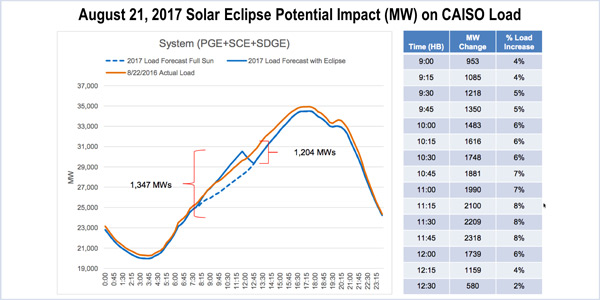By Robert Mullin
CAISO will lean heavily on increased output from conventional generators — and a backstop of regulation reserves — to fill the void left by reduced energy production from California solar resources during next month’s solar eclipse.
The grid operator estimates that about 4,194 MW of utility-scale solar will fall off the system from the time the moon begins to pass in front of the sun (9 a.m.) to the moment of peak obscuration (10:22 a.m.) during the Aug. 21 event.
At the peak, grid-connected solar generation will come up about 5,600 MW short of what would be expected under full-sun conditions. Net load will surge to about 6,000 MW above normal because of diminished output from rooftop installations.
But the grid operator has been preparing its response since last year. (See With Solar Eclipse Looming, CAISO Weighs its Options.) After a winter of ample precipitation, “large and fast-moving” hydroelectric resources are being positioned for rapid response during both the loss and return of solar, according to Deane Lyon, a CAISO real-time operations shift manager.
Planners are also banking on gas-fired generators to help cover the gap.
“We’re actually working with Pacific Gas and Electric and [Southern California Gas] and coordinating with their gas control centers because, besides the hydro, the gas-fired thermal is going to have to make up for a lot of the loss of solar generation,” Lyon said Tuesday during a bimonthly Market Performance and Planning Forum.
The ISO will also procure about 900 to 1,200 MW of regulation up reserves for the three-hour period affected by the eclipse — compared with a typical procurement of 300 to 400 MW.
“That’ll help us manage as the solar goes away,” Lyon said.
Lyon noted that CAISO has been consulting with Western Energy Imbalance Market (EIM) participants to develop a “consistent policy” regarding transfer service requests (ETSRs) — or dynamic transfers across balancing areas — during the eclipse so that the ISO can take advantage of imports to the greatest extent possible.
“We got commitments from the operations folks at the EIM entities that they’re willing to keep the ETSRs wide open and fully operational for the balance of the eclipse,” Lyon said, acknowledging that the ISO does not expect a “huge” uptick in transfers given that Arizona Public Service and NV Energy will also be losing solar off their systems at about the same time.
On the flip side, the eclipse is not expected to actually undercut imports.
“APS has solar, but not PacifiCorp,” Lyon said. “We don’t expect it will have that big of an effect.”
Paula Lipka, of PG&E’s short-term electricity supply team, asked if the ISO intends to increase its procurement of flexible ramping and spinning reserves — as well as regulation.
“An increase in flex ramp procurement is being considered. As far as spinning and non-spinning reserves, we will have adequate amounts of that,” Lyon responded.
Regulation reserves are the ISO’s key concern.
“We’re trying to maintain our system balance for the duration of the sun going away and returning, which is going to be a pretty big challenge,” Lyon said.





